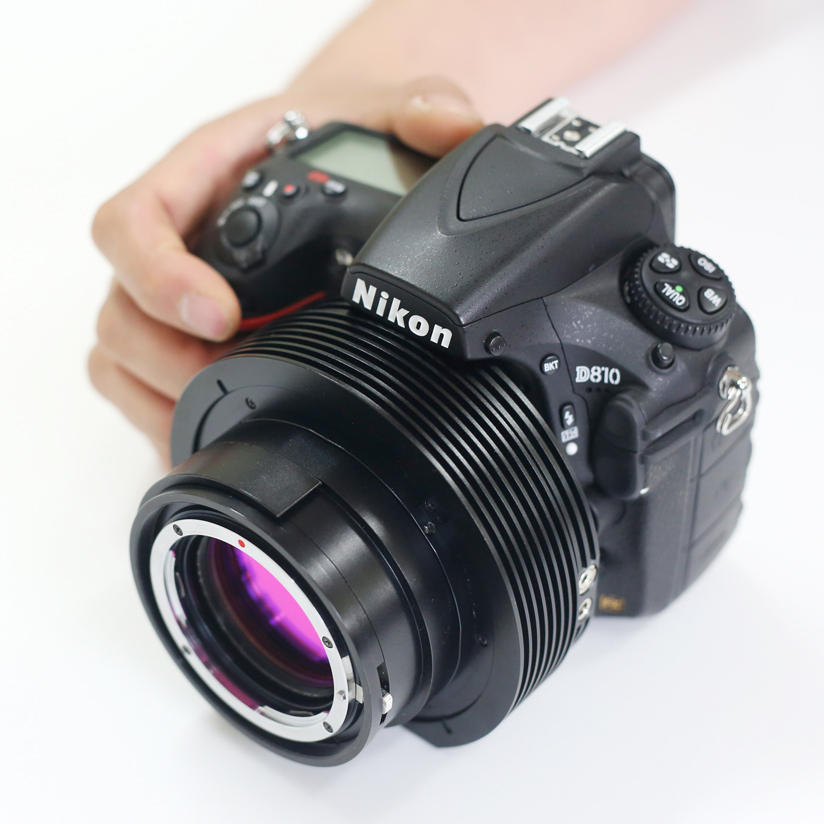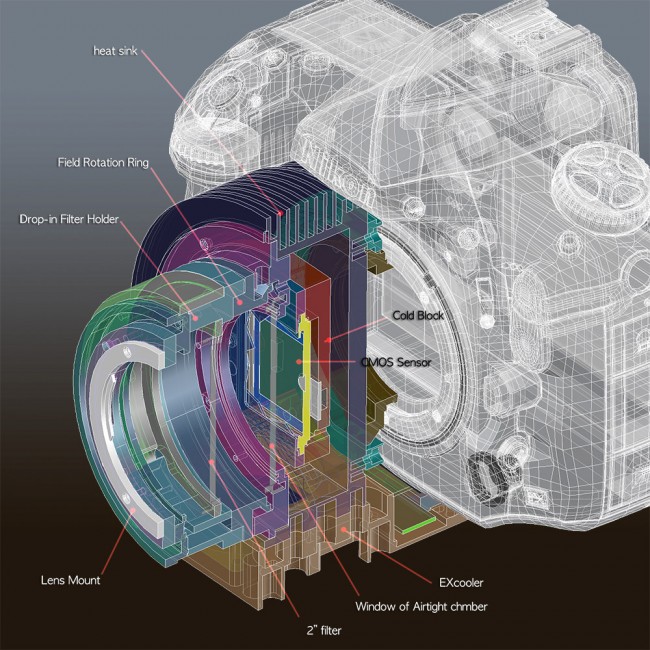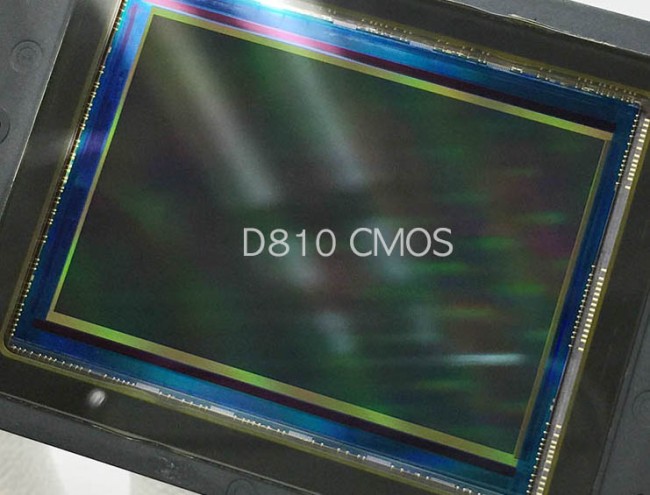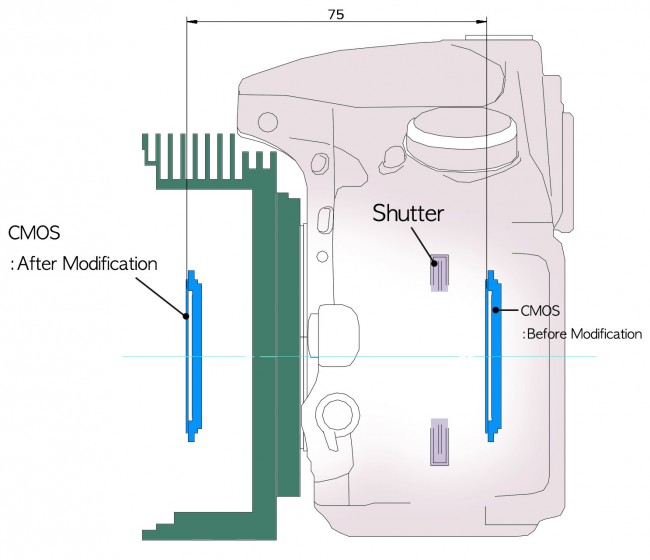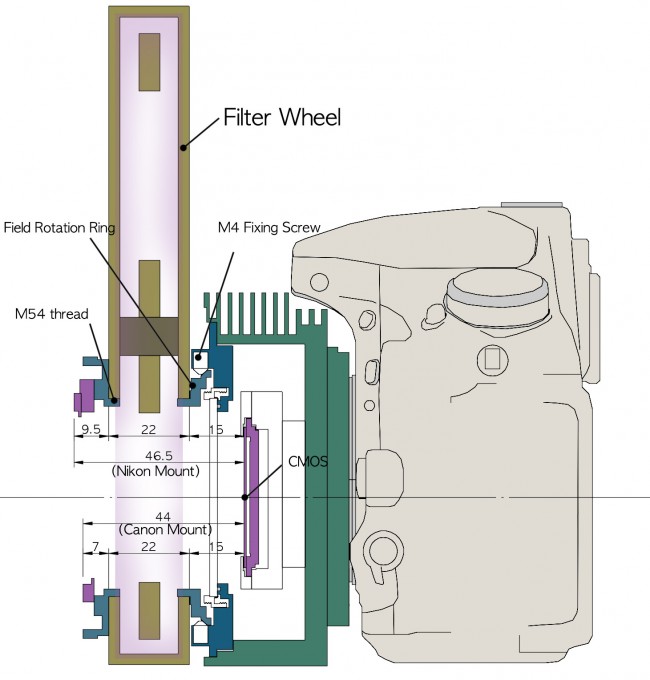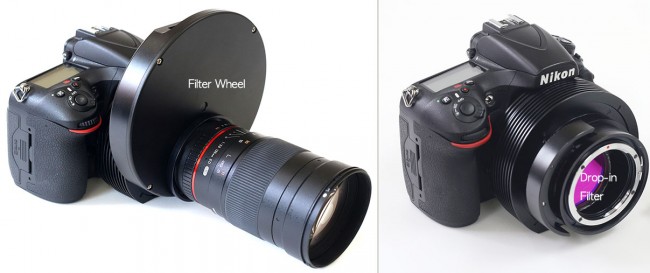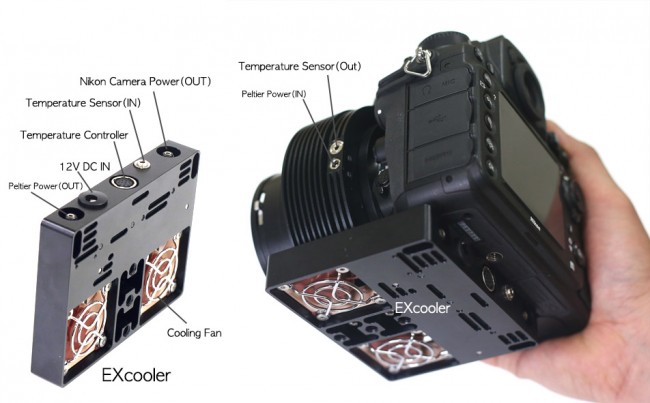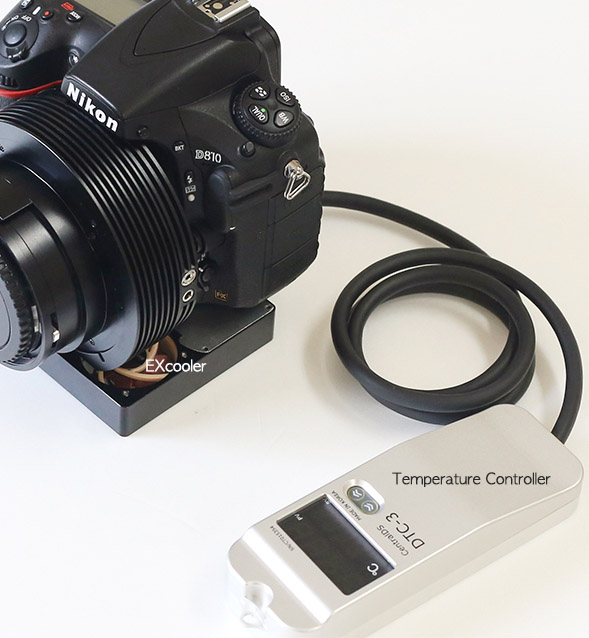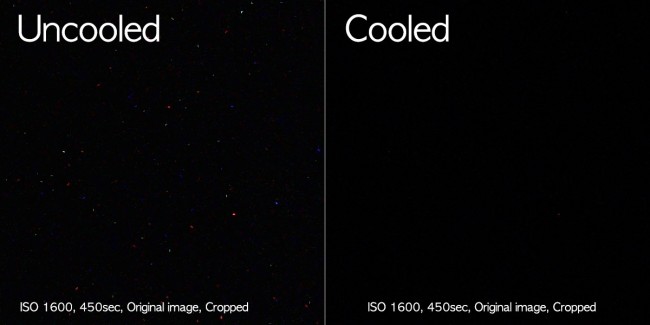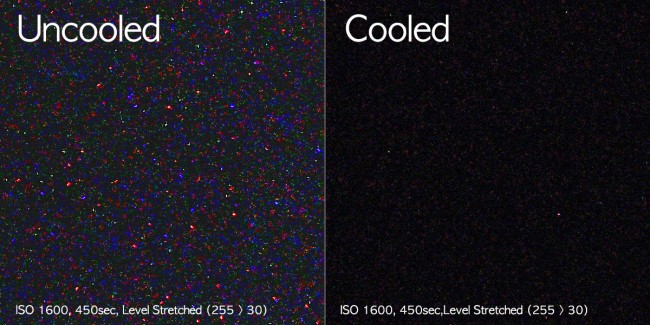Astro D810
Sony’s advanced semiconductor technology on micro wiring in CMOS made higher efficiency light gathering power in each pixel. And new data processing circuit and ADC placed in CMOS made possible to minimize noise when CMOS record the light signals.
In this case, only digital signals are tranfered to main board and digital signals are more free from environmental electric noise.
Nikon’s D810A and D810 are equipped with Sony’s new full frame 36Mega pixel CMOS sensor and these cameras became another good solution for astro photography compared to canon DSLRs.
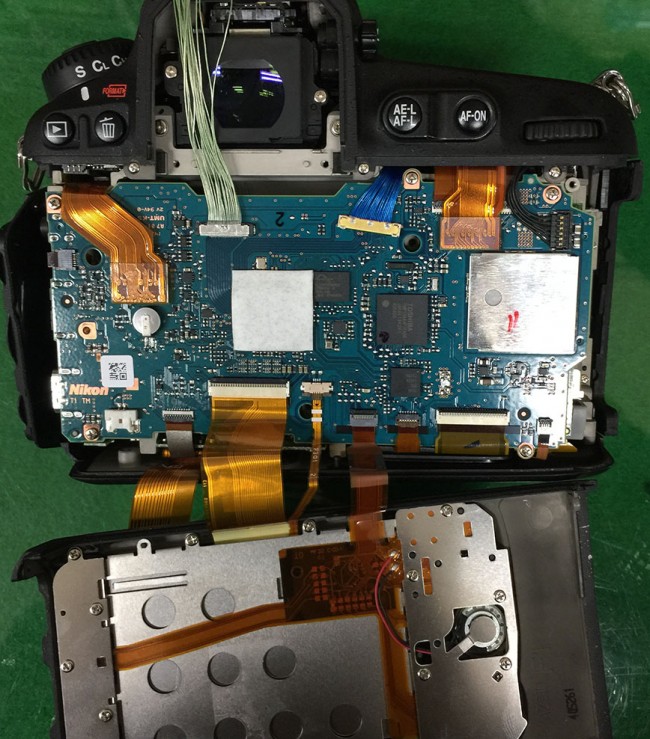
We disassembled D810 camera and checked whole parts and found that Nikon’s great efforts to take care user’s various photography environment and durable details. It’s good piece of work but having so tight inner structure and having no room for installation of cooling module.
Because we can’t secure any space in camera body, decide to take out CMOS from the camera body and make heat sink housing surrounding CMOS. This concept is the same way of Astro 6D and Astro A7s modification.
A. Relocation of Image Sensor.
We moved the image sensor 75mm toward lens mount and made a new connector cables to main board. Micro Coxial Cable for digital signals and FPC that ground circuit reinforced were made.
From the tests we have found that the power supply and signal transfer quality are same to original unmodified condition.
One interesting test result is. The long time exposure shots without TEC cooling of modified D810 are more good compared to the shots of unmodified D810. I think it may be caused by the image sensor that separated from noise source (electric parts of camera) and heatsink housing functioned as the shield cover preventing electric noises.
The relocation of the image sensor out of the body has merits and demerits.
Demerits:
.
1. the mechanical shutter is made redundant because the CMOS has been moved in front of the shutter.
Cameras control the amount of light to the image sensor by a combination of the mechanical and the electronic shutters.
The cooled D810’s exposure time will be controlled only by the electronic shutter which means exposure control of sub second exposures is not reliable.
In sub second shots, you can see the vertical gradation on image. It’s caused by the mismatch of closing time of electronic shutter in pixel rows of CMOS.
2. You are no longer able to use the optical viewfinder. However you can focus using the Live View mode.
3.The power supply and the electric communication from camera body to lens mount was disconnected. Autofocus and Electric Aperture control are impossible and only manual control will be valid.
Merit.
1. Drop in Filter System: The back focus distance between the image sensor and lens mount allowed sufficient room for the drop in filter holder or filter wheel. This system makes it possible to install filters without removing the lens. This is very useful including for narrowband imaging.
Astro D810 that equipped Drop-in filter system of filter wheel is having 46.5mm flange back distance as unmodified D810. Also you can choose canon mount too.
The filter wheels from other companies can simply be attached to Astro D810 camera. CentralDS will supply custom adapter when customers request. Because the field rotator concept was applied to the mount fixing, the slim adapter making by lathe will be possible.
2. The cylindrical heat sink and TEC cooling module is similar in shape to that of a normal DSLR and makes for a natural user experience.
3. The mirror holder of a full frame DSLR can cast a shadow onto the image sensor when it is lifted to take a shot. The amount of light is not too serious but can effect the regularity of the background brightness. This can be troublesome when constructing mosaic images, however the modified Astro D810 has no obstacles in front of the sensor.
B. Cooling system

1.High efficiency Heatsink: We designed the cylindrical airtight chamber that functioning heat sink . The surface area of the heat sink is became 30% larger ( 930cm² )than that of Astro 6D (720cm²) and more rapid heat radiation is possible.
2. 2 Stage Peltier Cooler :
The increased heat radiation area of Astro D810 make possible to apply 2 stage Peltier Module(Qmax with 65Watts, DTmax=80 ° C). Using this new TEC cooler we can get 140% cooling performance compared to that of Astro 6D, Astro A7s.
3. Passive Cooling :
 Digital camera is device that consuming electric power and the heat radiation from the electric parts is so natural. When the camera is working, the temperature of the image sensor rises to ambient +7C~ +10C. This rising temperature adds noise to the output image. In low light photography this internal heat is a major obstacle to overcome.
Digital camera is device that consuming electric power and the heat radiation from the electric parts is so natural. When the camera is working, the temperature of the image sensor rises to ambient +7C~ +10C. This rising temperature adds noise to the output image. In low light photography this internal heat is a major obstacle to overcome.
We designed a cylindrical heat sink by 3D modelling and manufactured it by MCT machine. This heat sink has sufficient radiation areas to allow a cooling of the image sensor to -10~-12C when the TEC is powered by 4v DC without the cooling fan.
BecauseCMOS temperature of the unmodified D810 is Ambient +7~+10C, the passive cooling without EXcooler of the Astro D810 is having a -18C cooling effect over the unmodified camera. Passive cooled D810 substantially assists in producing good quality night movies and time laps photography.
Passive cooling is fan less and is silent. The current consumption is only about 1.5 Amps and a 12v 12Ah lead sealed battery would allow about 8 hours of continuous use.
4.Active Cooling :
Two pieces of 40mm cooling fan are in EXcooler and these fans made possible [Ambient air temperature – 25C ] cooling temperature of CMOS.
5.Detachable EXcooler:
EXcooler of Astro D810 uses the fans of the Austrian “Noctua” company, renowned for their silent and high performance cooling fans.
EXcooler needed 12V DC input and including voltage step down circuit and OP Amp for temperature controller. And it supplies DC power to TEC and Nikon camera parts. DTC-3 temperature controller can be connected to EXcooler and users can decide the temperature of CMOS within the maximum cooling temperature [Ambient air temperature – 25C] .
C. Reliable Anti-Dew system
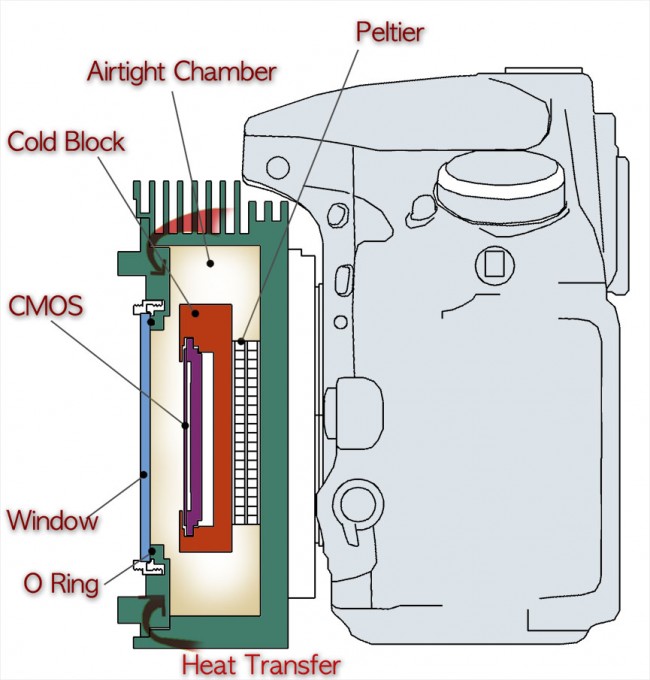
In high power cooling system, the anti-dew system is very important issue.
The Anti-Dew system of Astro D810 is having 4 major factors. volume of airtight chamber, surface area of cold block, temperature of surface of filter window, sealing are those.
We made small volume of airtight chamber to minimize the amount of vapor. And O ring on parts contact surfaces blocks the circulation of humid air from outside.
Coldest part in cooling system is cold block. We designed the shape of cold block to get big surface area and the dew condensation on this part will be sufficient for the total amount of vapor in airtight chamber. This concept will guarantee dew less CMOS. Because the temperature of CMOS is higher than that of Cold Block.
Second dewing surface is the out side of filter window.
We designed the heatsink to deliver the heat to filter holder. Then the hot filter holder make warm up the filter glass. The temperature of filter glass is slightly higher than ambient air temperature and it guarantee the anti-dew in filter window.
Due to our efforts as mentioned above Astro D810 can get permanent Anti-Dew system.
D. Temperature Controller

We added a terminal at EXcooler for Temperature controller. And in active cooling mode of Astro D810, DTC-3 temperature controller ( already used in CDS-5D, CDS-600DII) can be used.
In order to control the temperature of the CMOS sensor, DTC-3 manage electric current Input to Peltier module. DTC-3 is high performance external controller with the accuracy of +0.5~-0.5°C and is designed for easy use as well. DTC-3 is designed to reach target temperature at the shortest time through PID algolithm . By enabling a user to control the temperature in detail with accuracy, a user can save the effort of taking the dark frame pictures every single time and can easily produce a high quality astro-image picture because a user can easily adjust the dark frame on the pictures taken previously at each temperature.
E. simplified and standardized mechanical parts
In case of our former cooled camera models, the design solutions were so various as case by case. and it was impossible to standardize the parts.
The design concept of Astro 6D, Astro A7s, Astro D810 is based on moved CMOS toward to lens mount. In this concept many parts can be standardized.
We simplified the mount system of Astro 6D, A7s. 3 points alignment ring and field rotator, window holder were united into one.
In this new simple mount , we can make various customized adapters for many OTAs of customers as simple lathe machined parts.
M48, M54, M60, M72 or other thread can be accepted.
* Dark Frame Comparison
1. Indoor temperature, ASA1600, 450sec, RAW, 600x600pixels center Crop (Original)
2. Indoor temperature, ASA1600, 450sec, RAW, 600x600pixels center Crop (Photoshop Level 255 -> 30)

